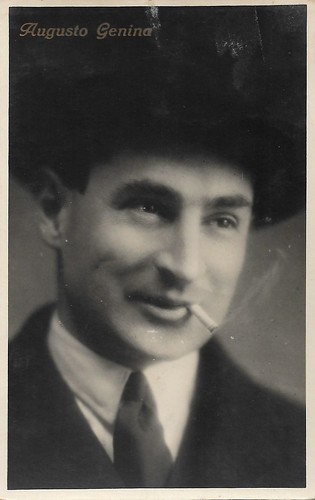
Italian postcard by G.B. Falci, Editore, Milano, no. 689. Augusto Genina.

Spanish minicard by Chocolate Amatller, Barcelona, no. 2 of 6.Photo: Milano Films, Mercedes Brignone and Livio Pavanelli in Il rubino del destino/The Ruby of Destiny (Henri Étiévant, 1914), scripted by Augusto Genina. The film was released in Spain as 'El rubí del destino; in January 1914.
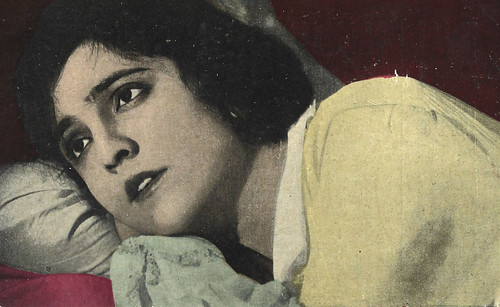
Spanish minicard by Chocolate Imperiale, card 6 of 6. Photo: Distr. J. Verdaguer, Barcelona / Itala Film. Maria Jacobini in Addio giovinezza!/Goodbye Youth (Augusto Genina, 1918). The Spanish release title was Adios, juventud!.
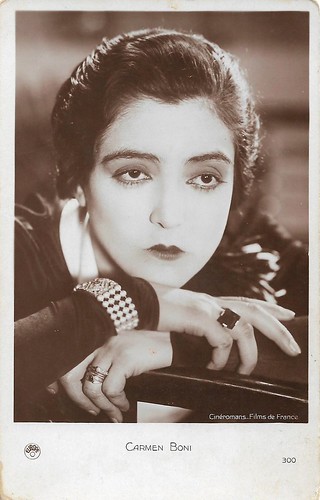
Italian postcard by Europe, no. 300. Photo: Cinéromans - Films de France. Carmen Boni probably in Totte et sa chance/La storia di una piccola Parigina (Augusto Genina, 1928), co-produced by Société des Cinéromans.
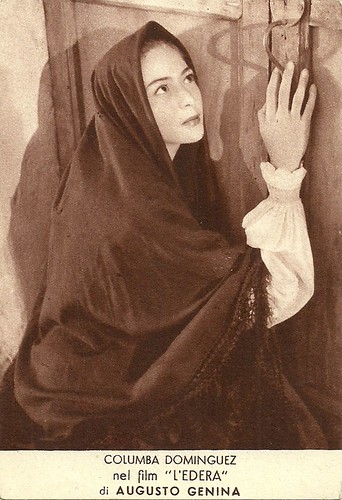
Italian postcard by Ed. Mondadori. Photo: Prod. Cines. Dist. ENIC. AGAR. Columba Dominguez in the Italian film L'edera/Devotion (Augusto Genina, 1950).
Genina's new muse and girlfriend
Augusto Genina was born in 1892 into an upper-class Roman family. His parents were Luigi Genina and Anna Tombini. After secondary school, he attended the Faculty of Engineering at the University of Rome, but never completed his studies as he soon became interested in theatre. From 1911, Genina was a playwright and drama critic for the magazine Il Mondo. On Aldo De Benedetti's advice, Genina switched to cinema as a scriptwriter for the Film d'Arte Italiana company, for which he edited the film adaptation of Beatrice d'Este (1912), starring Francesca Bertini. He later moved to Celio Film and then to Cines.
At Cines he began as assistant to director Giulio Antamoro. In 1913 he made his first film as director, La moglie di sua eccellenza/His Excellency's Wife (Augusto Genina, 1913), shot in Barcelona and produced by Film de Arte Español, the Spanish branch of Cines. A prolific director, he shot numerous films of different genres, many of them clearly derived from the theatre and centred on bourgeois marital dramas. During the First World War, Genina was released from service due to a permanent tendon injury suffered in his teens, which allowed him to continue filming regularly. In 1914 he worked for Milano Films and in 1915 for Medusa and Monopol, in 1917 for Ambrosio and Tiber, in 1918 for Itala and in 1920 for Photodrama in Turin.
Thus he directed female stars such as Maria Jacobini and Helena Makowska in Addio giovinezza!/Goodbye Youth (1918), a popular film he would remake in 1927 with Carmen Boni. With Jacobini he would also do L'onestà del peccato (1918). Other stars he worked with in the 1910s were Hesperia in Dopo il veglione (1914), Pina Menichelli in Lulù (1914), Bianca Virginia Camagni in La gelosia (1915), Mercedes Brignone in Mezzanotte (1915), Suzanne Armelle in La signorina Ciclone (1916), Yvonne De Fleuriel in Il trono e la seggiola (1918), Italia Almirante Manzini in Femmina (1918) and La maschera e il volto (1919), Diana Karenne in Lucrezia Borgia (1919), and Edy Darclea in Debito d'odio (1920).
Worthy of mention is the film Lo scaldino (Augusto Genina, 1920), starring Kally Sambuccini and Alfonso Cassini, and based on the novel of the same name by Luigi Pirandello, whose influence on Genina's work will also be seen in the later Prix de beauté/Miss Europa (Augusto Genina, 1930) starring Louise Brooks. In 1921 he founded Films Genina and in 1923 wrote the screenplay for Jolly, clown da circo, his cousin Mario Camerini's directorial debut. In the early 1920s, he also did films with Vera Vergani, Ria Bruna, and Soava Gallone, as well as adventure films such as Il corsaro (Augusto Genina, 1923) with Amleto Novelli. Despite the collapse of Italian film production, Genina still managed to continue making films, even if quite limited. In 1923 he directed the Franco-Italian prestigious early colour production Cirano di Bergerac/Cyrano de Bergerac, starring Pierre Magnier, Linda Moglia and Angelo Ferrari.
During the production of La moglie bella (1924), starring Linda Moglia, Genina discovered supporting actress Carmelita Bonicatti, better known as Carmen Boni. Boni became Genina's new muse and girlfriend, and eventually, in 1924, his wife. While Boni first starred in three Italian films by Genina: Il focolare spento (1925), L'ultimo Lord (1926) and Addio giovinezza! (1927), together they went to Berlin, where Boni starred in Genina's films Die Gefangene von Shanghai (1927), Scampolo (1928), with exteriors in Italy, Liebeskarneval (1928), Quartier Latin (1929), with exteriors in Paris, as well as the Franco-German coproduction Totte et sa chance/Der Sprung ins Glück/Die Geschichte einer kleinen Pariserin (1929). Eventually, Boni and Genina divorced, and both would remarry with others.

Italian postcard by Ed. Vettori, Bologna, no. 346. Sent by mail in 1926. Maria Jacobini in L'onestà del Peccato/The Wife He Neglected (Augusto Genina, 1918).
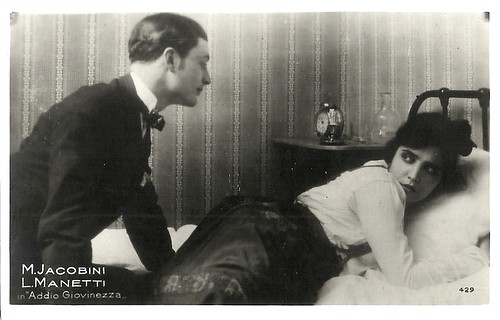
Italian postcard by Ed. Vettori, Bologna, no. 429. Maria Jacobini and Lido Manetti in Addio giovinezza!/Goodbye Youth (Augusto Genina, Itala Film 1918), a silent film adaptation of the play by Sandro Camasio and Nino Oxilia.
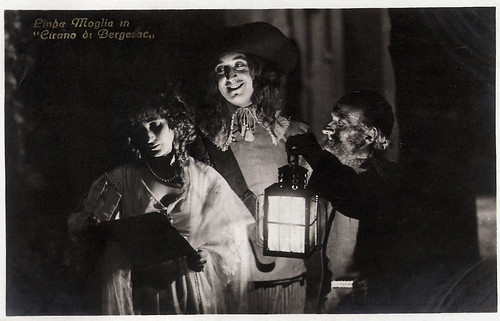
Italian postcard by G.B. Falci, Milano, no. 226. Photo: UCI. Pierre Magnier as Cyrano de Bergerac and Linda Moglia as Roxane in Cirano di Bergerac (Augusto Genina, 1923), based on Edmond Rostand's famous play Cyrano de Bergerac.

Italian postcard by Ed. G.B. Falci, no. 480. Photo: Film Genina. Carmen Boni in L'ultimo Lord (Augusto Genina, 1926).

Italian postcard by Ed. G.B. Falci, Milano, no. 698. Photo: Films Genina. Carmen Boni in Addio giovinezza/Goodbye Youth (Augusto Genina, 1927).

French postcard. by Cinémagazine-Edition, no. 710. Photo: Sofar. Carmen Boni in Quartier Latin/Latin Quarter (Augusto Genina, 1929). Orplid-Film produced the film, Messtro-Film distributed it in Germany.
One of Fascism's leading filmmakers
In 1929 Augusto Genina directed Louise Brooks in the highly successful Prix de beauté (1930), a film shot in silent and later soundtracked version, scripted by René Clair and Georg Wilhelm Pabst. In 1931 he directed both the German and the French versions of Mitternachtsliebe/Les amours de minuit, co-directed respectively with Carl Froehlich and Marc Allégret, and starring Danièle Parola in both versions. Memorable is also Paris-Beguin (1931) with Jean Gabin and Jane Marnac, while Boni and Genina did two last films together in France: the comedies La femme en homme (1932) and Ne sois pas jalouse (1934). In 1934 Boni and Genina divorced. In 1939 he married the British Elisabeth 'Betty' Becker.
In the mid-1930s Genina changed employers, starting with a series of Italo-German coproductions with opera stars such as Beniamino Gigli and Erna Sack. After almost a decade abroad, Genina made a definitive return to Italy in the late 1930s. In 1936, he directed the war film Lo squadrone biancoThe White Squadron (Augusto Genina, 1936) in the Libyan desert, which won the Mussolini Cup for Best Italian Film at the Venice Film Festival.
He became one of Fascism's leading filmmakers, making L'assedio dell'Alcazar (1939), another propaganda war film illustrating an episode from the Spanish Civil War, and Bengasi (1942), a film about the British attack on the Italians in the Libyan city during World War II. He alternated these with lighter fare such as Naples au baiser du feu/The Kiss of Fire (1937), a film that secured singer Tino Rossi a big success, and Castelli in aria (1939), a comedy with Lilian Harvey and Vittorio De Sica. Yet, in 1942 Genina stopped directing after Bengasi and it would take at least eight years before he started again directing.
In the post-war period, Genina attempted an approach to neorealism with Cielo sulla palude/Maria Goretti (1949), a biographical work about Maria Goretti, filmed in a wonderful Caravaggesque style by Aldo Graziati, but critics found his melodramatic realism too mannered at the time. In 1950 Genina directed L'edera, based on the novel of the same name by Grazia Deledda. In Tre storie proibite (1953), Genina filmed the story of the collapse of a staircase that swept away a large number of young girls who had rushed to find a job as typists, already the subject of Giuseppe De Santis's film Roma ore 11. In 1953 Genina also directed the film Maddalena, set in the Sannio region in the characteristic villages of Guardia Sanframondi and Cerreto Sannita. The film starred Gino Cervi and Swedish actress Märta Torén.
In 1955 Genina shot his last film, Frou Frou (1955), after which he retired due to endocarditis from which he had suffered for a long time. Augusto Genina died in 1957. All in all, he directed almost 100 films, wrote almost 50 scripts and produced 2 films.
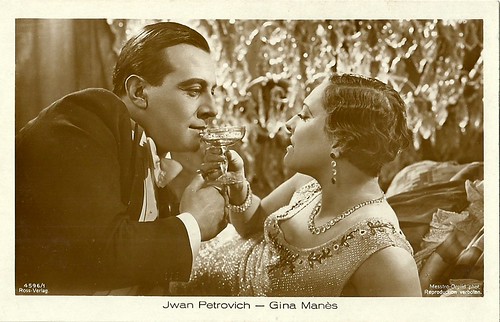
German postcard by Ross Verlag, no. 4596/1, 1929-1930. Photo Messtro-Orplid. Ivan Petrovich and Gina Manès in Quartier Latin (Augusto Genina, 1929).

Dutch collectors card in the series 'Filmsterren: een portret' by Edito Service, 1995. Photo: Stars-Films. Louise Brooks in Prix de Beauté (Augusto Genina, 1930).
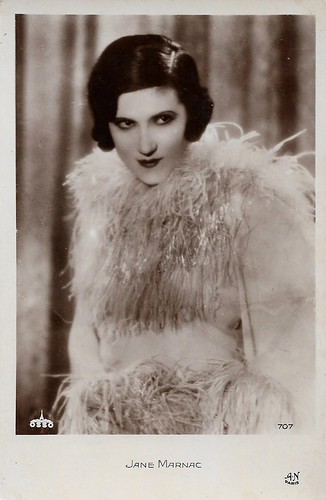
French postcard by A.N., Paris, no. 707. Photo: Les Films Osso. Jane Marnac in Paris-Béguin (Augusto Genina, 1931).

French postcard by Radiogravure A. Breger Frères, Arcueil. Photo: publicity still for the Italian colonial film Lo squadrone bianco/White Squadron (Augusto Genina, 1936), starring Antonio Centa and Fosco Giachetti. The film focuses on Italian troops in Africa and was based on a French novel by Joseph Peyré, 'L'escadron blanc', but in adapting the original French novel for an Italian film, the French soldiers in Algeria were changed to Italian soldiers in Libya.
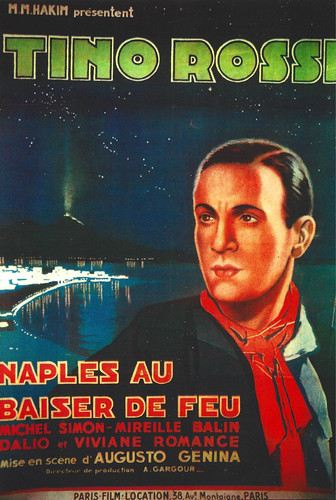
French postcard by Encyclopédie du cinéma, Carte artistique et cinématographique. Reproduction of French film poster for the film Naples au baiser de feu/The Kiss of Fire (Augusto Genina, 1937), starring Tino Rossi.

Italian postcard by ASER. Photo: Bassoli, Tirrenia. Fosco Giachetti in Bengasi (Augusto Genina, 1942).
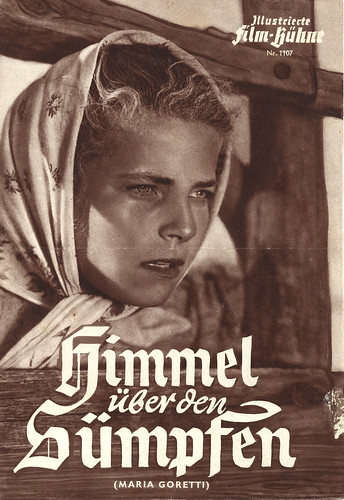
German film brochure by Illustrerte Film-Bühne, no. 107. Film special on the Italian film Cielo sulla palude/Heaven over the Marshes (Augusto Genina, 1949), a historical drama on the life of little (afterwards Saint) Maria Goretti, played by Ines Orsini, and filmed with Caravaggesque cinematography by Aldo Graziati (G.R. Aldo').
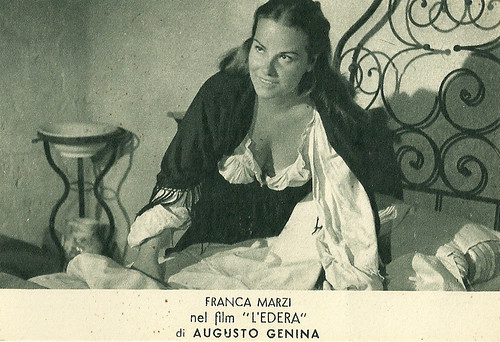
Italian postcard by Ed. Mondadori. Photo: Prod. Cines. / Dist. ENIC / AGAR. Franca Marzi as Zana in L'edera/Delitto per amore/Devotion (Augusto Genina 1950).
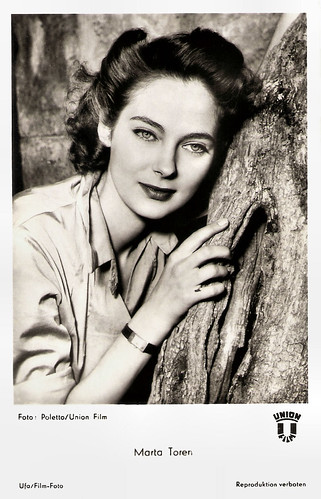
German postcard by Ufa, Berlin-Tempelhof, no FK 1079. Photo: Poletto / Union-Film. Marta Toren in Maddalena (Augusto Gennina, 1954).
Sources: Wikipedia (Italian) and IMDb.
No comments:
Post a Comment